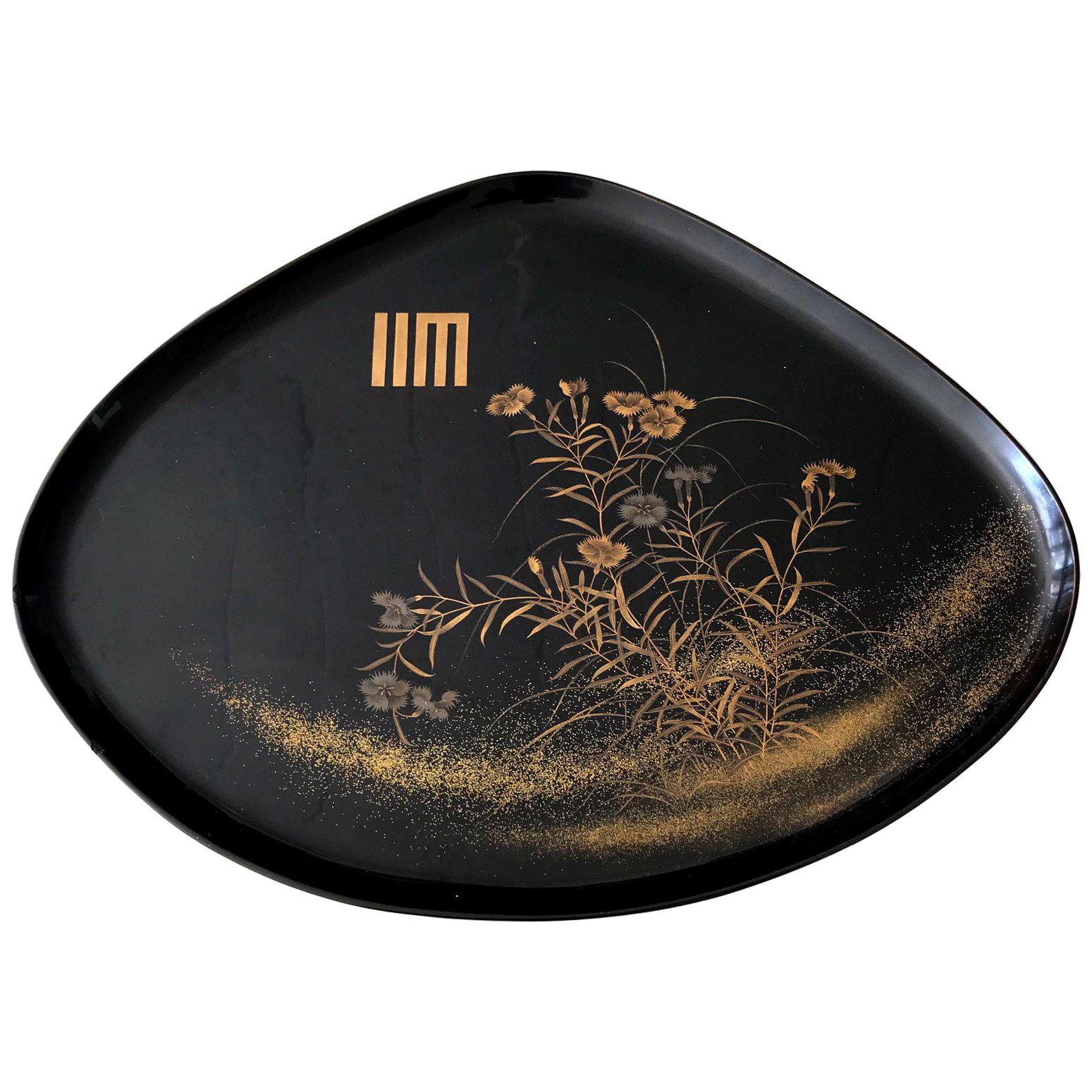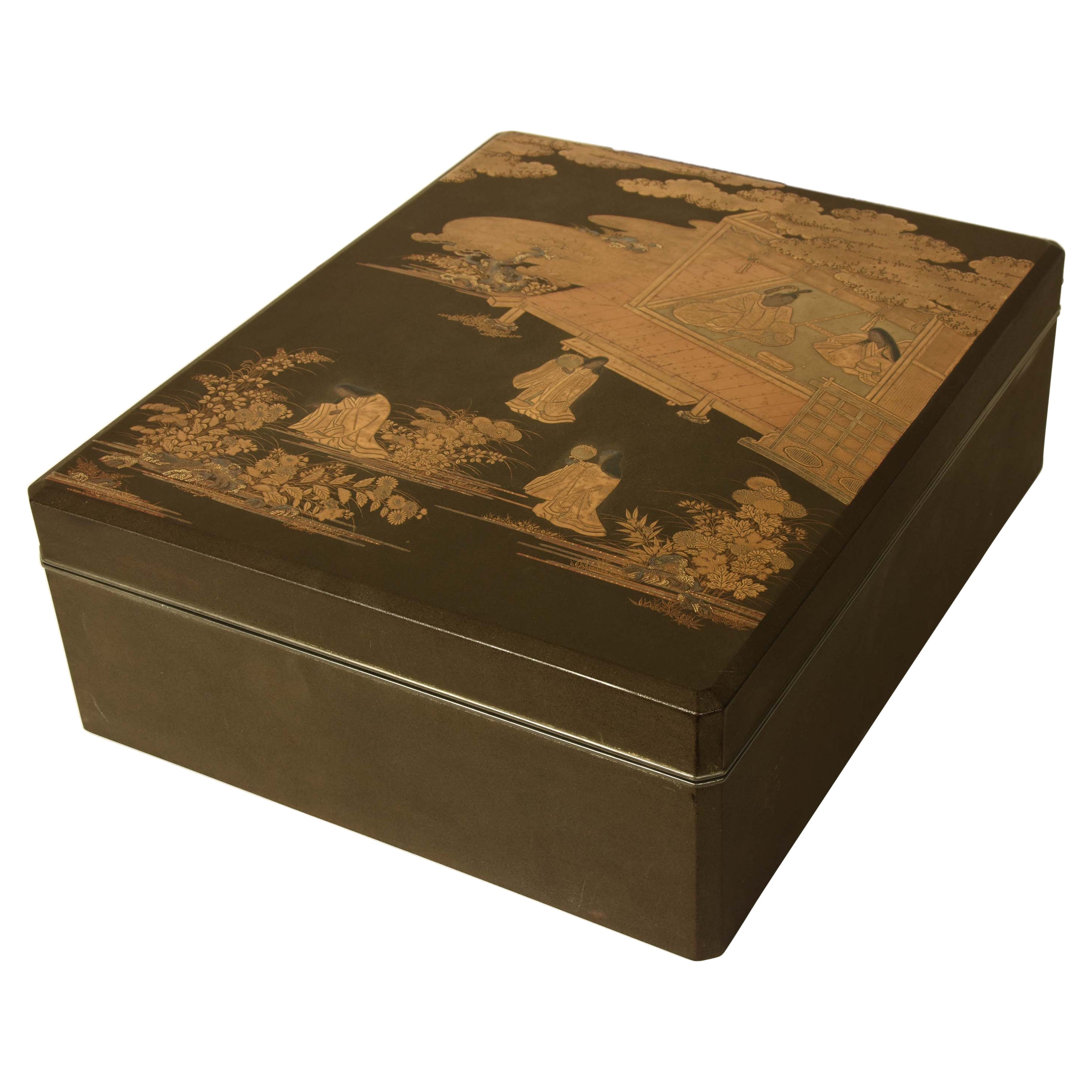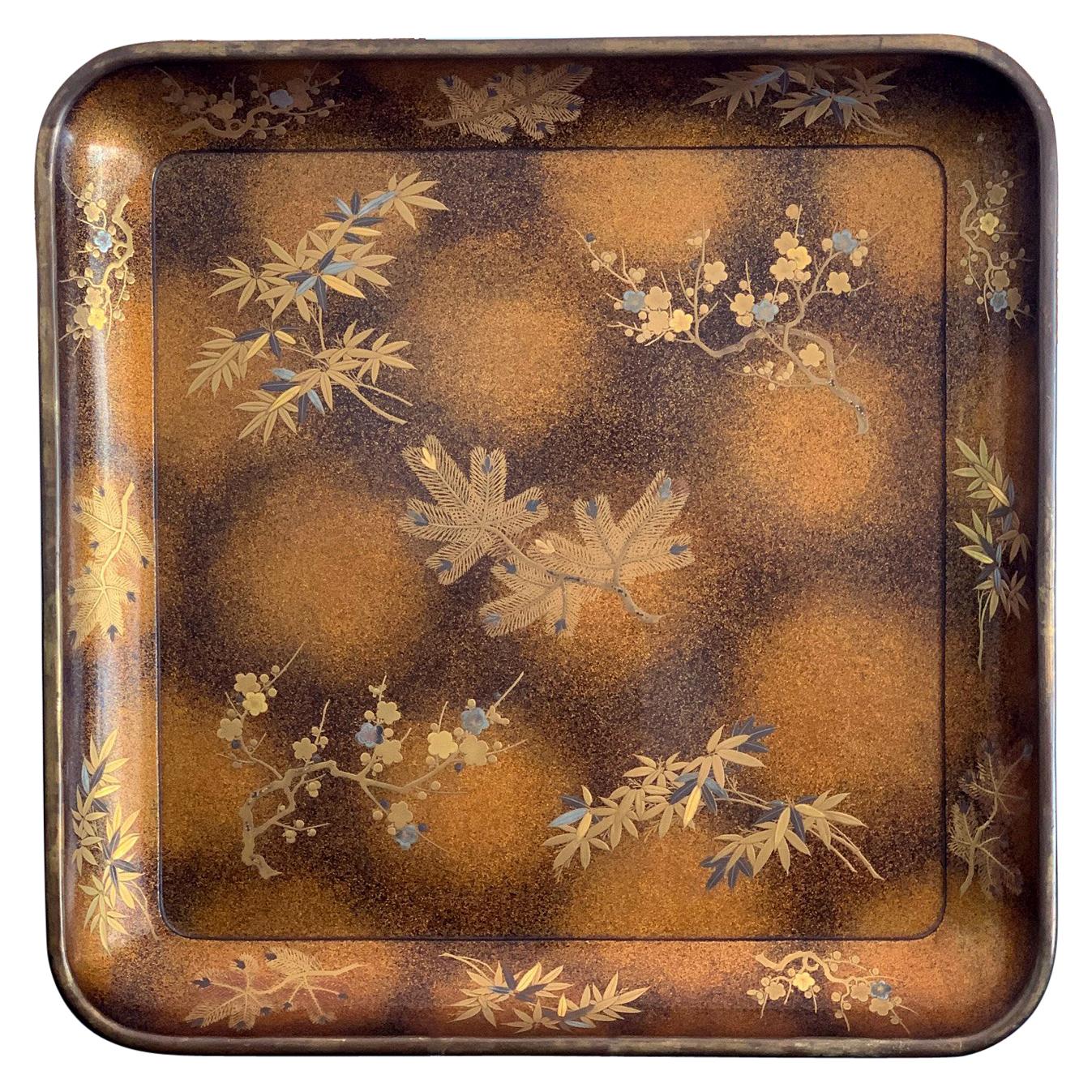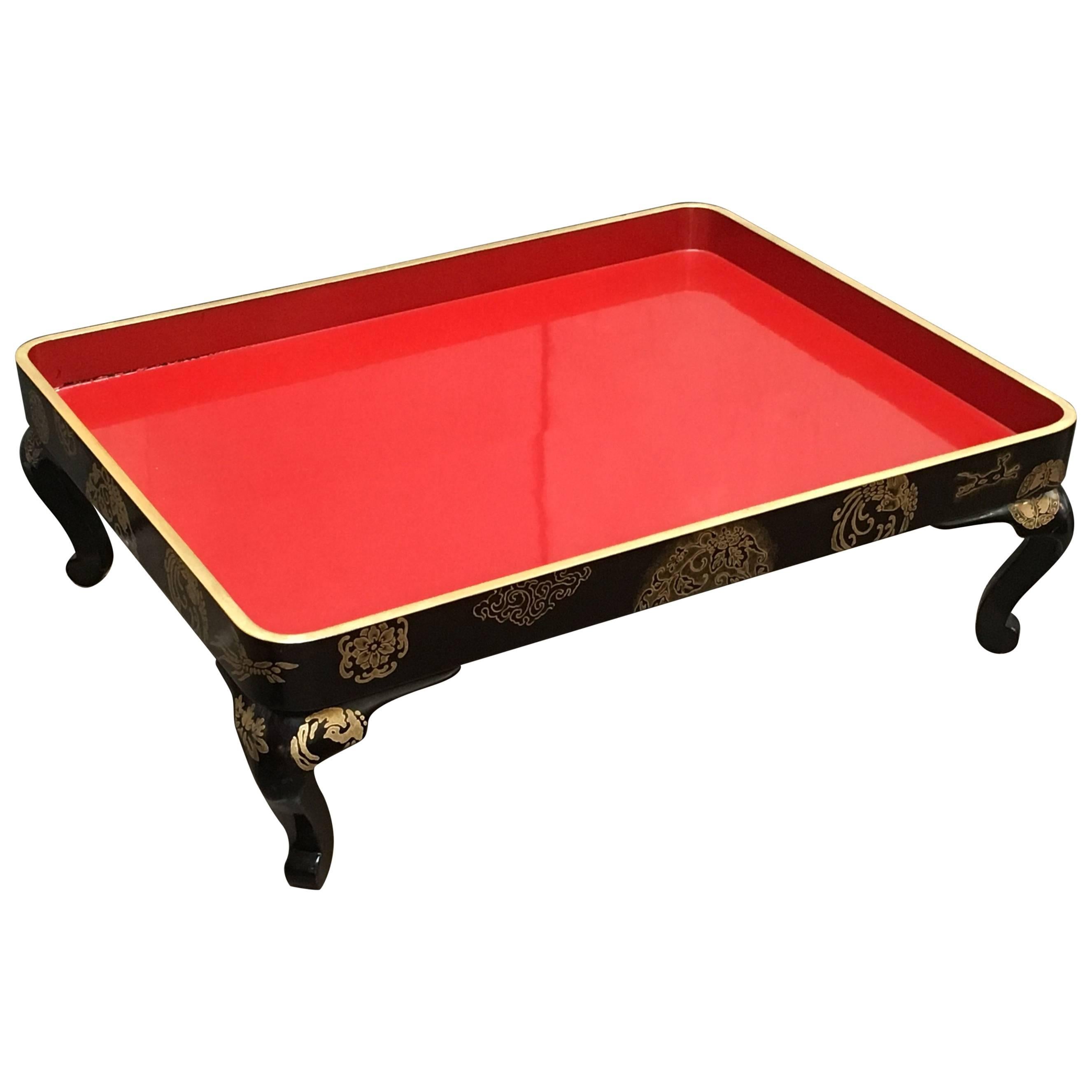Items Similar to Japanese Maki-e Lacquer Tray Box with Cutout Design
Want more images or videos?
Request additional images or videos from the seller
Japanese Maki-e Lacquer Tray Box with Cutout Design
About the Item
A Japanese lacquer box with lid and an inner tray decorated with Maki-e on a dense nashiji background. The fine box was likely made circa 1920-30s during the Tashio period and likely used for tea ceremony. The low relief hiramaki-e depicts a gentle hilly landscape with flowering bushes with silver highlight, grasses, ferns and pines in the distant. The design was intentionally sparse, with a poetic and painterly composition. What's unusual about the box is that there is cut-out design of four characters on the lid and the wall respectively. The two words read "Deep Thought" on the lid and "Philosophical Study" on the wall. The pieced words were traced with gold fundame that renders the characters a highlighted dimension. There are also two gold maki-e characters on the side of the box "intention".
The fitted tray has a leaf motif design. The interior and base were finished in a dense nashiji.
- Dimensions:Height: 4.25 in (10.8 cm)Width: 7.25 in (18.42 cm)Depth: 3.75 in (9.53 cm)
- Style:Taisho (Of the Period)
- Materials and Techniques:
- Place of Origin:
- Period:
- Date of Manufacture:20th century
- Condition:Repaired: A small professional restoration about 0.2 inch on one of the strokes of the character as shown. Wear consistent with age and use. Overall good condition with expected light surface wear including small losses on the fundame along the rim, shelf wear on the base.1500.
- Seller Location:Atlanta, GA
- Reference Number:1stDibs: LU945037104812
About the Seller
5.0
Platinum Seller
These expertly vetted sellers are 1stDibs' most experienced sellers and are rated highest by our customers.
Established in 2006
1stDibs seller since 2010
480 sales on 1stDibs
Typical response time: <1 hour
- ShippingRetrieving quote...Ships From: Atlanta, GA
- Return PolicyA return for this item may be initiated within 2 days of delivery.
More From This SellerView All
- Large Japanese Lacquer Tray with Maki-e Carp Design Meiji PeriodLocated in Atlanta, GAA large rectangular tray with scalloped corners and slightly raised gallery rim circa late 19th century to early 20th century (end of Meiji period). The center image showcases a live...Category
Early 20th Century Japanese Japonisme Lacquer
MaterialsLacquer
- An Antique Japanese Lacquer Maki-e TrayLocated in Atlanta, GAA fan shape black lacquer tray from Japan circa 1910-30s, late Meiji to early Showa era. Elaborated decorated with a bundle of yomogi blossom in a very fine Maki-e technique using both gold and silver powders. There is a Japanese symbol on the top left, which represents yomogiu, stemming from yomogi (蓬), a wild plant that belongs to the chrysanthemum family and widely grown in Japan. This name yomogui is from a scene in the Tale of Genji...Category
Early 20th Century Japanese Japonisme Lacquer
MaterialsLacquer
- Japanese Maki-e Lacquer Stack Box JubakoLocated in Atlanta, GAAn antique jubako (stack boxes) with five tiers in an elongated octagon shape circa 19th century (end of Edo or beginning of Meiji period). jubako was traditionally used to store and...Category
Antique 19th Century Japanese Japonisme Lacquer
MaterialsWood, Lacquer
- Large Vintage Japanese Maki-e Lacquer Kimono TrayLocated in Atlanta, GAA large square lacquer presentation tray (likely for kimono) predated 1950 of the Showa period. Elaborately decorated with Maki-e that depicts the prunus blossom, bamboo and needle p...Category
Vintage 1940s Japanese Japonisme Lacquer
MaterialsWood, Lacquer
- Japanese Lacquer Box with Fine Maki-e Decoration Meiji PeriodLocated in Atlanta, GAA lacquered wood box with lid from Japan circa 19th century Meiji Period. The finely decorated box was used to store paper slips and small documents on the desk. It is overall finished with black lacquer (kuro) with sparse Mura-Nashiji effect outside and on the top surface of the lid, there are three Komainu, (sometimes known as Shishi or Japanese lions) frolicking and forming a circle in lively motion. Komainu are auspicious animals in Japanese cultures in both Shinto and Buddhism tradition. Originally from China, these animals symbolizes guardians to ward off evil spirits. Hiramaki-e was used in combination with carving and combing to render the lions with various surface textures. A gilt border with an slight angle was given to the lid and even the thin band is decorated with miniature floral scrolls. The interior of the box was finished in a dense nashiji. Underneath the lid, a cluster of peonies open lavishly by two gentle mounts. Takamaki-e (high relief) in both gold and silver were...Category
Antique Late 19th Century Japanese Japonisme Lacquer
MaterialsWood, Lacquer
- Japanese Lacquer Tray with Maki-e and Inlay Hara Yoyusai Edo PeriodLocated in Atlanta, GAA lovely Japanese lacquer rectangular lacquer tray with a slightly scalloped corner and four L shape supporting feet by one of the most celebrated lacquer artist active in Edo period Hara Yoyusai (1772-1845). Yoyusai lived in Edo (Tokyo) and worked under the patronage of Lord Matsudaira. He operated a large workshop and had a very prolific output of lacquer objects. Most survived pieces being inro...Category
Antique 19th Century Japanese Japonisme Lacquer
MaterialsWood, Lacquer
You May Also Like
- Japanese Black Lacquer Document Box with Gold Maki e Design, Meiji PeriodLocated in Prahran, VictoriaAn antique black lacquer document box with an exquisitely detailed, finely wrought design from The Tale of the Genji depicted in gold maki e across the lid. Internally, the box is de...Category
Early 20th Century Japanese Lacquer
MaterialsWood, Lacquer
- Japanese Red and Black Lacquer Maki-e Decorated Presentation Tray, dated 1917Located in Austin, TXA fine Japanese red and black maki-e lacquer presentation tray with original tomobako storage box, Taisho period, dated 1917, Japan. The large prese...Category
Vintage 1910s Japanese Taisho Lacquer
MaterialsGold
- Japanese Maki-e Lacquer Stacking Box, Jubako, Meiji Period, JapanLocated in Austin, TXA fine and impressive Japanese gold maki-e decorated black lacquer five-tier jubako with presentation tray, two lids, and the original tomobako storage box, Meiji period, late 19th c...Category
Antique Late 19th Century Japanese Meiji Lacquer
MaterialsLacquer
- A Japanese maki-è lacquer inroLocated in Milano, ITJapanese inro with two compartments, in maki-è lacquer with nashiji decorations and circular reserves depicting flowers and leaves. Coral colored ojime and lacquer manju netsuke. Si...Category
Antique Mid-19th Century Japanese Japonisme Lacquer
MaterialsLacquer
- Japanese Meiji Period Antique Lacquer Box with Gold Maki-e DecorationLocated in New York, NYA fine antique Japanese Meji Period lacquer box decorated with a fan and a stylized star shaped window in the maki-e technique. The fan at the top right corner, fully opened depictin...Category
Antique 19th Century Japanese Meiji Lacquer
MaterialsLacquer
- Edo Maki-e Japanese BoxLocated in Brescia, ITJapanese box with lacquer lid finely decorated with Maki-e, dating from the 18th century, mid-Edo period. The box is of special size to preserve important calligraphy. All sides of ...Category
Antique Late 18th Century Japanese Edo Lacquer
MaterialsGold Leaf
Recently Viewed
View AllMore Ways To Browse
Japanese Decorated Trays
Japanese Decorated Trays
Japanese Lacquer Furniture 16th Century
Japanese Silver Hawk
Lacquered And Japanned
Japanese Red Lacquer Furniture
Japanese Antique Red Lacquer
Japanese Chrysanthemum Incense Burner
Large Japanese Lacquer Bowl
Japanese Bento Box
Japanese Lacquer Bento Box
Antique Japanese Lacquer Kobako
Cockerel Seal
Japanese Antique Bento
Sofu Teshigahara
Bento Box Vintage
Red Shibayama
Vintage Wooden Paper Tray





